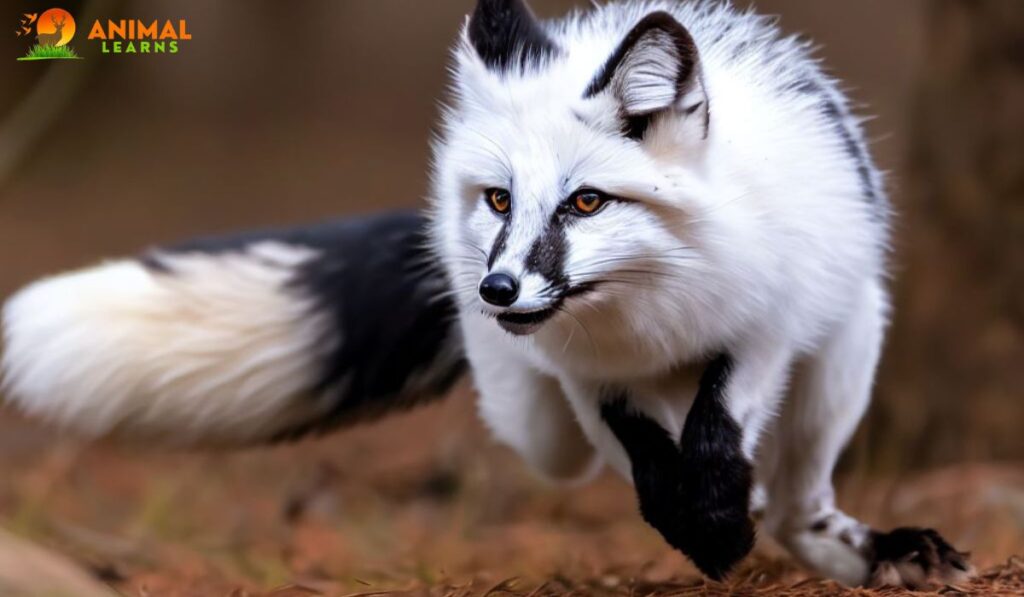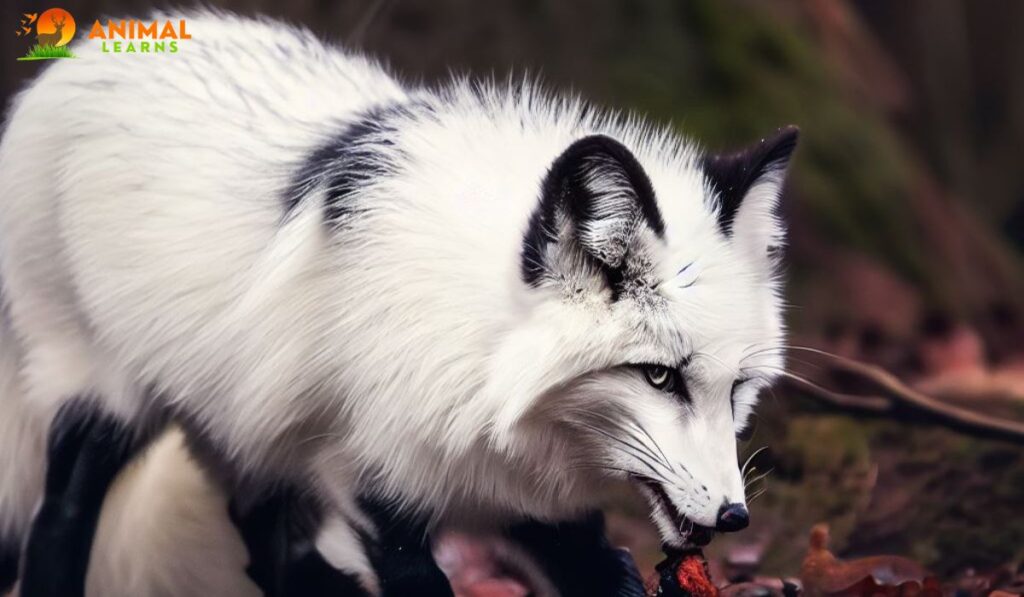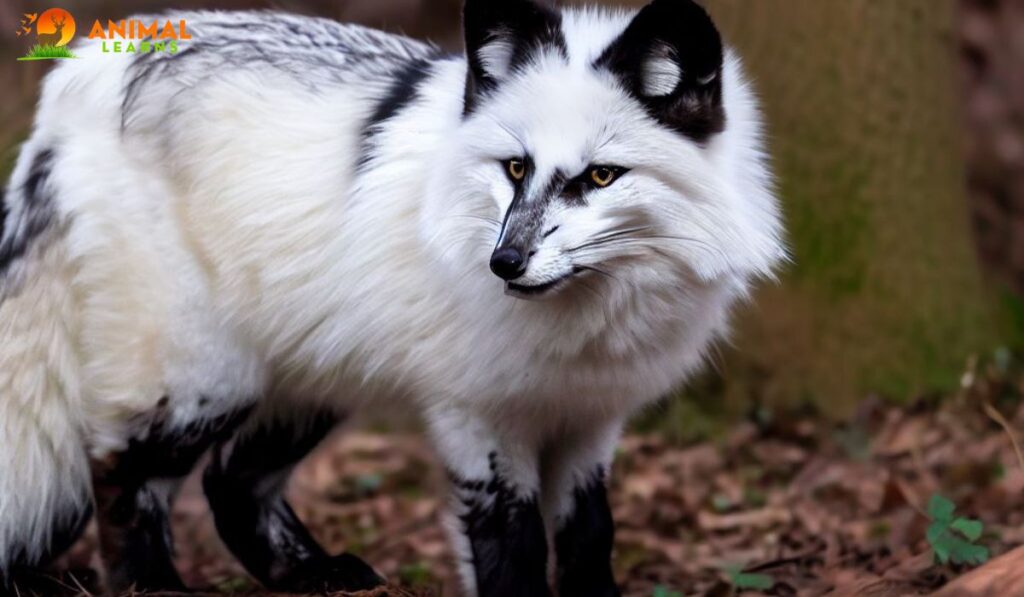Canadian Marble Fox | Nature’s Beauty
The Canadian Marble Fox is not a natural species, but a man-made one. It is a cross between the red fox and the silver fox. They have a beautiful black and white fur that makes them look like marble.
The Canadian Marble Fox, unlike the Bengal fox, is a distinct species known for its strikingly beautiful and unique marbled coat. The fur looks like it has been painted by an artist with a delicate brush.
But the most eye-catching feature of this fox is the dark rings around its eyes, which give it a mischievous look. Some people call it the burglar’s mask as if the fox is hiding its identity after stealing something.

The fox also has a reddish-orange tail and a white belly that contrasts with its marbled coat. It is easy to spot and admire this beautiful animal. Some people even keep it as a pet, but be warned: this fox is still wild at heart and needs special care and attention.
Did you know that the Canadian fox is not a natural fox? The first marble fox was born in 1945 on a farm in Norway, where a red fox and a silver fox mated and produced mutant offspring. This offspring had a beautiful coat that looked like marble, with white and black stripes.
This coat was so unique and attractive that some people started to breed this fox for its fur. They called this process “color phase” because it changed the color of the fox. They also called this fox the Arctic Marble Fox, even though it was not from the Arctic.
| Name | Canadian Marble Fox |
| Scientific Name | Vulpes vulpes |
| Size (Adult) | 20 to 30 inches (51 to 76 cm) in length |
| Weight (Adult) | 6 to 15 pounds (2.7 to 6.8 kg) |
| Fur Color | White with gray or black marbling |
| Lifespan | 5 to 10 years in the wild, longer in captivity |
| Range | Primarily found in northern Canada |
| Habitat | Tundra and forested regions |
| Diet | Omnivorous, including small mammals, birds, and vegetation |
| Behavior | Nocturnal, solitary, and generally shy |
| Conservation Status | Not formally assessed, but populations are stable |
Exploring the Canadian Marble Fox
Contents
The Canadian-Marble Fox, a captivating creature with unique marbled fur patterns, has piqued the curiosity of wildlife enthusiasts. This species, native to Canada and some northern U.S. states, thrives in snowy landscapes and exhibits intriguing behaviors. To fully understand this enigmatic fox, one must delve into its habitat, size, and behavior. Additionally, questions about owning a Canadian Fox as a pet and its legal status in various regions have sparked interest and debate.
Habitat and Range
What Country Is Home to the Canadian Fox?
North America’s northern regions are home to the intriguing Canadian-Fox, which is distinguished by its marbled fur. Its habitat encompasses all of Canada and some northern regions of the United States. Due to their propensity for colder weather, these areas offer the perfect setting for these species to flourish.

Modifications for Extreme Weather
The ability of the Canadian-Fox to adapt to extreme weather is one of its amazing qualities. The extreme winters and chilly temperatures in their habitat provide serious difficulties, yet these foxes have evolved special defenses to deal with them.
They differ from other fox species because of their thick fur, which serves as an insulating covering and keeps them warm even in below-freezing temperatures. Furthermore, even in snowy environments, they can acquire food sources thanks to their adept hunting abilities.
Monogamous nature and solitary lifestyle
It is well known that Marble Foxes lead lonely lives and are monogamous. They tend to spend solitary lives, unlike some other fox species, and only gather in groups during the breeding season. They create monogamous pairings at this time to demonstrate their close relationship with a single partner.
The Canadian Fox’s distinctive social behavior adds to its mystique, making it an intriguing object of study and awe among nature lovers.
Behavior and Characteristics
Unusual Hunting Methods

In contrast to its canine counterparts, this Fox has a unique hunting style. This strategy is specifically tailored to its habitat and preferred prey. These foxes are exceptional hunters because of their agility and stealth. They frequently rely on their sharp senses, especially their superb hearing, to spot prey movements even through thick snowfall. They may stand still for long stretches of time while waiting for the right opportunity to pounce on their unsuspecting victim, which makes patience another important component of their hunting strategy.
Behavioral Patterns and Traits
The Marble Fox’s behavioral characteristics and habits reveal important details about its enigmatic nature. These foxes display solitary and monogamous behavior in concert. Although they live alone most of the time, during breeding season they establish monogamous partnerships and demonstrate a strong affinity with their chosen mate.
The continuation of their distinctive genetic characteristics, like as the sought-after marbled fur pattern that distinguishes them, is ensured by their breeding practices.
Thick, Desirable Fur
The thick, prized fur of the Marble-Fox is one of its most alluring characteristics. Because of their beautiful coat, which protects them from the bitter cold of their arctic home, they are in high demand in the fur trade. Their appeal is enhanced by the marbled pattern on their fur, which differs from individual to individual.
Unfortunately, development has also exposed them to habitat loss and hunting. To prevent further exploitation of these foxes and their exquisite fur, conservation initiatives are essential.
Diet and Feeding Habits
What Diet Do Canadian Foxes Follow?

Carnivorous predators, Canadian foxes have a diversified diet that shows their capacity to adapt to their environment in the north. Small mammals including mice, hares, and voles make up their main diet. They are also opportunistic feeders and will eat carrion, insects, and birds when it is there. They may occasionally scavenge on the carcasses of larger animals that other predators have left behind.
They rely on their stash of food that has been saved to keep them alive during the harsh winter months when hunting is more difficult.
Hunting Techniques and Preferences for Prey
To capture their prey, Marble Foxes use a variety of hunting techniques. They are skilled hunters thanks to their agility and excellent senses, which include keen eyesight and acute hearing. They frequently stalk their prey covertly, using patience and stealth to approach within striking distance. They use a quick pounce when the time is ideal to seize their prey.
Smaller mammals, which are common in their natural habitat, including snowshoe hares and voles, tend to be their preferred prey. Their hunting habits are coordinated with the species’ seasonal availability. They are known to rely significantly on hunting snowshoe hares in the winter when the snowy surroundings serve as camouflage. In contrast, their diet may change during the warmer months to include a greater variety of small mammals, birds, and insects.
Their ability to survive in the harsh conditions of the Canadian wilderness, where food availability can change drastically with the seasons, depends on their ability to use a variety of hunting techniques and dietary modifications.
Domestication and Legal Considerations
Can Canadian Foxes Be Kept as Pets?
Depending on where you live, keeping Canadian Foxes as pets may or may not be permitted. As a result of worries about the welfare of the animals and potential hazards to people, it is restricted or outlawed in many areas. These laws are frequently in place to safeguard both the public and foxes.

To legally acquire a Canadian Marble Fox in some places, you might need to obtain a permission or license. These authorizations, however, are normally only given to people or groups who have the training and resources required to properly care for these creatures. Before selecting a Canadian Fox as a pet, it is crucial to do your homework and comprehend the local ordinances.
Considering the Issue of Risk
Because they are wild creatures, Vulpes vulpes maintain many of their innate instincts and behaviors even when they are reared in captivity. Even while they may develop ties with people, they may still behave erratically and have territorial instincts. Safety issues are brought up by this unpredictability, particularly when interacting with kids or other animals.
Possibility of Being a Domestic Animal
Experts disagree on whether Marble Foxes are suitable to be tamed. While some claim that knowledgeable people who are prepared to give them the specific care and attention they need may keep them as pets, others stress the difficulties and hazards involved.
To fully comprehend the ethical and practical ramifications of ownership, it is essential to speak with local authorities, wildlife specialists, and exotic animal physicians before thinking about keeping a Vulpes vulpes as a pet.
A Canadian Fox As A Pet
Training and Exercise
They are amazing and playful pets, but they also need a lot of exercise and stimulation to stay healthy and happy. You should provide them with plenty of space to roam and explore, and let them enjoy their natural curiosity. To prevent them from getting lost or into trouble, you should have a secure outdoor enclosure with a strong fence.

Training a Fox can be a rewarding but challenging experience. They are smart animals who can learn tricks and commands, but they also have a mind of their own and may not always obey you. You should be patient and consistent with your training, and use positive reinforcement to motivate them.
Grooming And Cleaning
These Foxes are beautiful and exotic pets, but they also need a lot of care and attention. One of the most important things you can do for your fox is to keep its living space clean and fresh. You should clean their enclosure regularly, removing any waste and giving them fresh water every day. Foxes are smart and tidy animals, and they may choose specific spots for their waste, which makes cleaning easier for you.
Another thing you can do for your fox is to groom them occasionally. Canadian Marble Foxes have thick and fluffy fur that sheds dirt naturally, and they are very good at grooming themselves. However, you should still check their fur for any signs of matting or foreign objects, and gently remove them if you find any. This will help your fox stay comfortable and healthy.
Keeping An Aggressive Attitude
Canadian Marble Foxes are adorable and fluffy, but they can also be fierce and feisty. They may act aggressively if they feel scared or threatened, or if they want to protect their territory. You can help your fox become more friendly and calm by giving them positive human interactions and socializing them from an early age. But you should also respect their space and mood, and approach them with care and caution.
If your fox shows signs of violent behavior, don’t panic or punish them. Instead, seek professional help from an animal behaviorist or a vet who has experience with exotic animals. They can give you tips on how to handle aggression in a safe and compassionate way.
Challenges and Disadvantages
These Foxes are stunning and unique animals, but they are not for everyone. Owning one as a pet can be a rewarding but difficult experience, and there are many challenges to consider before making this decision. Here are some of the main challenges you may face if you decide to adopt a Marble Fox as a pet:

Legal Restrictions
You may not be allowed to own a Canadian Fox as a pet in your area. Some places have strict laws that prohibit or regulate exotic animals as pets. You should check your local and national laws before you think about getting one.
Aggressive Behavior
Not all Foxes are friendly and cuddly. Some of them can be fierce and feisty, especially if they feel scared or threatened, or if they want to protect their territory. You need to socialize them well and respect their space and mood. You also need to be careful of their bites and scratches, which can hurt you and your fox.
Specialized Care
These foxes have specific needs that you need to meet. They need outdoor enclosures that are secure and spacious, and they need access to cold climates where they can thrive. They also need a special diet and regular veterinary care. Meeting their needs can be hard and expensive.
Limited Availability
You may not find a Canadian Fox easily. They are not common as pets, and finding a reputable breeder can be tough. You should be wary of buying from sources that may be illegal or unethical, and that may harm the foxes or the environment.
Zoonotic Diseases
Like all foxes, Canadian Foxes can carry diseases that can infect humans. You need to take precautions and get regular check-ups for your fox and yourself. You also need to vaccinate your foxes and keep them away from other animals that may carry diseases.
Noise and Odor
Foxes can be loud animals, and their calls can annoy you and your neighbors. They also have a strong smell that can be hard to get rid of in your home. You need to be prepared for the noise and odor that come with owning a fox.
Lifespan Commitment
They can live for a long time in captivity, up to 14 years. This means you need to be ready for the long-term commitment of caring for them. You need to think about your future plans and how they may affect your fox.
Financial Responsibility
Owning a Marble Fox can cost you a lot of money. You need to pay for their enclosure, food, veterinary care, and other supplies. You also need to consider the potential costs of damage or liability that your fox may cause.
Wild Instincts
Even though they are domesticated, Vulpes vulpes still have many of their wild instincts. This means they may not be easy to train or control, and they may behave unpredictably or destructively. You need to be patient and consistent with your training and use positive reinforcement to motivate them.
Limited Social Interaction
These foxes are not very social by nature, and they may not seek or enjoy human companionship as much as other pets like dogs or cats. You need to respect their independence and personality, and not expect them to be your best friend.
10 facts about the Canadian Fox

- Distinct Coat: The Canadian Marble Fox has a stunning coat that sets it apart from other foxes. Its fur is white with black patches, giving it a marbled look. Its coat also changes color according to the season, from white in winter to brown in summer.
- Northern Habitat: The Canadian Fox lives in the northern regions of Canada, where the climate is cold and harsh. It prefers to live in forests, grasslands, and tundra habitats, where it can find shelter and food.
- Adaptation to Cold: Marble Fox has a special adaptation that helps it cope with the freezing temperatures in its native habitat. It has a thick and insulating fur coat that keeps it warm and cozy. Its fur also helps it camouflage with its surroundings.
- Largely Solitary: This Fox is a solitary animal that likes to have its own space and territory. It hunts and lives alone, except for mating and raising its young. It also communicates with other foxes using vocalizations, body language, and scent marking.
- Monogamous Bonds: The Canadian Marble Fox is known for its monogamous nature. It forms a long-term pair bond with one partner, and they stay together for life. They also share the responsibility of raising their offspring, which are called kits.
- Stealthy Predators: The Canadian Marble Fox is a skilled and cunning hunter. It uses stealth and precision in its hunting style, often stalking its prey before pouncing on it. It has keen senses of sight, smell, and hearing that help it locate and catch its prey.
- Diverse Diet: The Canadian Marble Fox is an omnivorous animal, which means it eats both plants and animals. It mainly hunts small mammals, birds, and insects, using its sharp teeth and claws. It also eats fruits, berries, nuts, and grasses when they are available.
- Behavioral Mysteries: The Canadian Marble Fox has many intriguing behaviors that fascinate researchers and wildlife enthusiasts. For example, it has been observed to play with objects or other animals, showing signs of curiosity and intelligence. It also has been seen to perform rituals or dances before mating or hunting, showing signs of emotion and culture.
- Pet Ownership: This Fox is not a common or easy pet to own. The legality of owning one as a pet varies by location. Some places allow it, while others ban it or regulate it strictly. You should check your local and national laws before you consider getting one as a pet.
- Charming Elegance: This is an elegant and charming animal that captivates people with its beauty and mystery. It has a graceful appearance and movement that make it look like a work of art. It also has a playful and friendly personality that makes it look like a loyal companion.
Conclusion
The Canadian Marble Fox is a stunning and elusive animal, full of mysteries and charms. It has amazing adaptations to survive the harsh Canadian winters, such as its thick and beautiful fur. It lives a solitary life, but it mates for life with one partner. It is a fascinating animal to learn about and admire from a distance.
However, owning a Canadian Marble Fox as a pet is not an easy or simple choice. You need to think about the legal issues, the risks, and the challenges of taking care of this exotic animal. They may look cute and cuddly, but they are not like regular pets. They have special needs and behaviors that you need to respect and understand. These wonderful creatures deserve our respect and protection in their natural habitat, where they can continue to enchant us with their beauty and mystery.
FAQs
Where does it live?
The Canadian Fox is native to Canada, especially in the northern regions where the climate is cold and snowy. It prefers to live in forests, grasslands, and tundra habitats.
How long does it live?
In the wild, the Canadian Marble Fox has a short lifespan of about 3 to 4 years. This is because it faces many threats from predators, diseases, and human activities. In captivity, it can live up to 14 years with proper care and attention.
Is it legal to own a pet?
The legality of owning a Canadian Marble Fox as a pet depends on where you live. Some places allow it, while others ban it or regulate it strictly. You should check your local and national laws before you consider getting one as a pet.
How does it survive the harsh weather?
The Canadian Marble Fox has a unique adaptation that helps it endure the severe winter weather. It has a thick and insulating fur coat that keeps it warm and cozy. Its fur also changes color according to the season, from white in winter to brown in summer, to blend in with its surroundings.
Is it faithful to its partner?
Yes, the Canadian Marble Fox is known for its monogamous nature. It forms a long-term pair bond with one partner, and they stay together for life. They also share the responsibility of raising their offspring, which are called kits.
What does it eat?
The Canadian Fox is an omnivorous animal, which means it eats both plants and animals. It mainly hunts small mammals, birds, and insects, using its keen senses of sight, smell, and hearing. It also eats fruits, berries, nuts, and grasses when they are available.
How does it behave in the wild?
The Marble Fox is a solitary animal that likes to have its own space and territory. It has a unique hunting style, often stalking its prey before pouncing on it. It also communicates with other foxes using vocalizations, body language, and scent marking.












